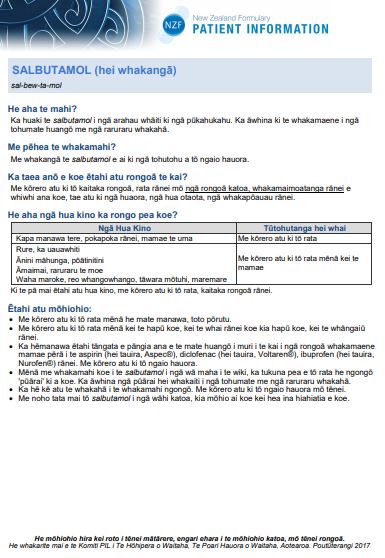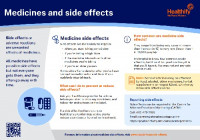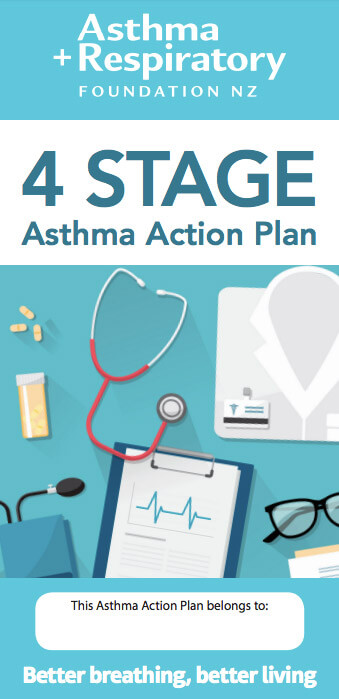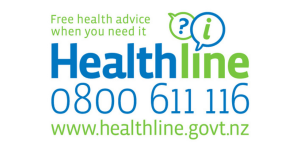Wishing everyone a safe and happy Christmas and New Year – Meri Kirihimete from the Healthify team.
Salbutamol
Sounds like 'sal-bew-ta-mol'
Key points about salbutamol
- Salbutamol is used to quickly relieve breathing problems such as wheeze and cough caused by asthma and COPD.
- Salbutamol is commonly called Ventolin®, SalAir® or Asthalin®.
- For asthma, using salbutamol by itself, without an inhaled corticosteroid, is no longer recommended.
- Find out more about salbutamol, how to use metered dose inhalers and possible side effects.

Salbutamol is a medicine used to treat cough, wheeze and difficulty breathing caused by respiratory problems such as asthma and COPD. It works as a bronchodilator (to open your airways) and is often called a reliever (to relieve breathing problems).
Salbutamol relieves your breathing problems quickly. It starts to work within a few minutes and the effect will last 3 to 5 hours.
Although it relieves breathlessness, salbutamol doesn’t prevent the breathlessness from happening.
Salbutamol metered dose inhalers (MDI)
Using salbutamol in an MDI helps the medicine go straight into your airways when you breathe in. This means that your airways and lungs are treated quickly and very little of the medicine gets into the rest of your body.
Always use a spacer with your MDI.
- It makes it easier to use your MDI: Many people are unable to use their MDI properly because you need good coordination to press the inhaler and inhale at the same time. The spacer reduces the need for perfect timing. A spacer allows you to press the inhaler and then inhale at a steady pace, making it easier to use.
- It gets more medicine to your lungs: Compared to using your MDI without a spacer, using a spacer delivers much more medicine (up to twice as much) to your lungs where it’s needed. Less medicine ends up in your mouth and throat.
Salbutamol metered dose inhalers are available in different brands
In Aotearoa New Zealand salbutamol metered dose inhalers are available as Salair® and Ventolin®.
- There's no difference in the amount of medicine between the different brands of inhaler but Ventolin doesn't contain any chlorofluorocarbons (CFCs) or alcohol in it.
- SalAir is fully funded with a prescription. If you choose the Ventolin brand you’ll have to pay part of the cost for it.
Salbutamol nebulising solution
- Nebulisers are not often used because, for most people, puffer inhalers used with a spacer are just as effective. Nebulisers are only used when inhalers aren’t suitable, such as for very young children, older adults or very sick people in hospital.
- The information on this page is about salbutamol inhalers. Read more about nebulisers.
Read more about metered dose inhalers and inhalers and climate change.
If you have asthma, using salbutamol alone is no longer recommended because:
- it doesn’t deal with the underlying cause of wheezing which is caused by an inflammation of the lining of your bronchial tubes
- using salbutamol without an inhaled corticosteroid can make asthma worse by increasing inflammation and sensitivity to allergens
- using salbutamol too often makes it less effective, so you need it more frequently
- using 3 or more salbutamol inhalers a year is linked to a higher risk of needing emergency care or being hospitalised, no matter how severe your asthma is.
What is recommended?
The recommended treatment for people with asthma 12 years of age and over is a combination 2-in-1 inhaler containing the preventer medicine budesonide and the reliever medicine formoterol.
The brand names for these inhalers are Symbicort® or DuoResp Spiromax®. These inhalers can be used as either a reliever treatment alone (AIR), or as a regular preventer and reliever treatment (SMART).
Read more about AIR and SMART asthma therapy.
The usual dose of salbutamol inhaler is 1 or 2 puffs, preferably through a spacer device.
This dose can be repeated up to 4 times a day if you need it for shortness of breath or wheezing.
If you’re needing to use your salbutamol inhaler more than 2 times a week, see your doctor to change your treatment, or increase the dose of your steroid inhaler, to help control your symptoms.
Before exercise: If you’re using salbutamol to prevent asthma brought on by exercise, the usual dose is 1 or 2 puffs inhaled 15 to 30 minutes before exercise.
Use your MDI with a spacer
- A spacer is an attachment to use with your inhaler. It's a chamber that holds the medication before you inhale, giving you a more controlled, deeper inhalation. This can be especially helpful if you are short of breath.
- Using your salbutamol inhaler with a spacer makes it easier to use the inhaler and helps to get the medicine into your lungs, where it’s needed (with less medicine ending up in your mouth and throat).
Check your technique
- To get the most benefit from your inhaler, it's important to use the correct technique.
- Ask your healthcare provider to show you how to use your MDI and spacer devices.
- Even if you’ve been shown before, ask your healthcare provider to explain how to use your inhaler if you still have any questions.
The videos below provide some guidance on how to use a spacer with your MDI. Note: Your MDI or spacer may look different to the one in the videos below.
Video: How to use your spacer device
(Healthify He Puna Waiora, NZ and Auckland District Health Board, 2018)
Video: MDI and spacer
(Asthma Waikato, NZ, 2018)
Here are some things to know when you're taking salbutamol. Other things may be important as well, so ask your healthcare provider what you should know about.
- Check your inhaler technique regularly: It's very important to use your inhalers correctly, otherwise you may not be getting enough medicine into your lungs. Ask your healthcare provider to watch you use your inhaler so you can be sure you're doing it properly.
- Clean your MDI ONCE a week: Your inhaler can get blocked if medicine builds up inside it, so try to clean it weekly.
- Asthma action plan: Ask for a written asthma action plan from your asthma nurse or healthcare provider. This will tell you how many puffs to use for each dose, and what to do if your symptoms get worse. Read more about asthma action plans for adults(external link) and children(external link).
- Taking other medicines: Salbutamol interacts with some medicines including herbal supplements and rongoā Māori, so check with your doctor or pharmacist before starting salbutamol and before starting any new products. Some people with asthma might have trouble breathing after taking painkillers like ibuprofen (Nurofen®) or diclofenac (Voltaren®). If this happens, talk to your doctor.
- Keep your inhaler with you at all times: Make sure you have your inhaler with you at all times so you know where it is when you need it.
- Holidays: Make sure you have enough salbutamol and any preventer steroid inhalers to last through weekends and holidays.
- Storage: You can carry your inhaler in your pocket but it needs to be stored below 25ºC, so don't keep it in your car during summer.
Do you need a preventer?If you need to use your salbutamol inhaler more than 2 times each week, talk to your doctor. To reduce your symptoms you may need a ‘preventer’ inhaler, or the dose of your preventer inhaler may need to be increased. Preventers help reduce asthma symptoms and breathing problems. You’ll get better control of your symptoms with a 2-in-1 combination inhaler (reliever + preventer) instead of just salbutamol. Read more about preventers and combination inhalers such as Symbicort or DuoResp Spiromax. |
Like all medicines, salbutamol can cause side effects, although not everyone gets them. Often side effects improve as your body gets used to the new medicine.
| Side effects | What should I do? |
|---|---|
|
|
|
|
|
|
|
|
Read more about medicines and side effects and reporting a reaction you think might be a side effect.
The following links provide further information on salbutamol.
SalAir(external link), Ventolin(external link) Medsafe Consumer Information Sheet, NZ
Salbutamol inhaler and nebules(external link) New Zealand Formulary Patient Information
Brochures
Salbutamol (for inhalation) New Zealand Formulary Patient Information te reo Māori(external link)
4 stage asthma action plan Asthma & Respiratory Foundation, NZ English(external link), Māori(external link), Samoan(external link)
5 questions to ask about your medications(external link) Health Quality and Safety Commission, NZ, 2019 English(external link), te reo Māori(external link)
Apps/tools
There are variety of mobile apps available for people with asthma. These can be a useful way to learn about and take control of your asthma, for example they can help you keep track of your symptoms, triggers, peak flow readings and medication. You can also create an asthma action plan together with your doctor or nurse. The New Zealand Health App Library has reviewed some asthma apps that you may like to consider. Read more about asthma apps.
References
- Salbutamol (respiratory)(external link) New Zealand Formulary
- Salbutamol(external link) New Zealand Formulary for children
- Some asthma inhalers contain very small amounts of ethanol(external link) Medsafe, NZ, 2018
- The pharmacological management of asthma in adolescents and adults has changed(external link) BPAC, NZ, 2020
- Inhaler carbon footprint(external link) He Ako Hiringa, NZ, 2023
Brochures

My Medicines, NZ, 2017

Medicines and side effects
Healthify He Puna Waiora, NZ, 2024
Credits: Healthify editorial team. Healthify is brought to you by Health Navigator Charitable Trust.
Reviewed by: Dr Roland Meyer, Specialist Physician, Respiratory and General Medicine
Last reviewed:
Page last updated:






